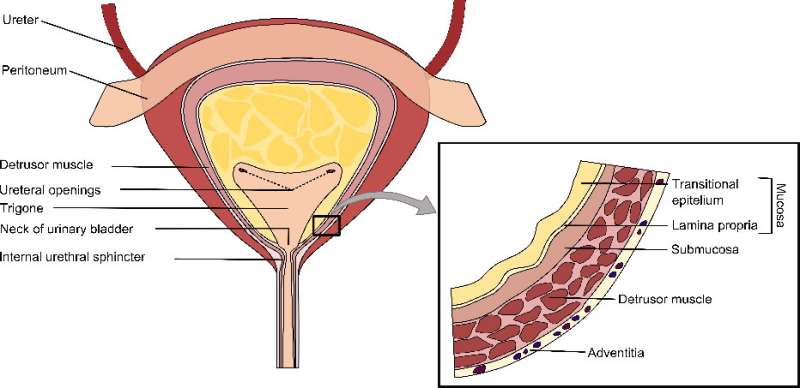Understanding the mechanics of the urinary bladder

Dr. S. Roccabianca and Dr. T.R. Bush, researchers from Michigan State University compiled an extensive review of the key contributions to understanding the mechanics of the bladder ranging from work conducted in the 1970s through the present time with a focus on material testing and theoretical modeling. The review appears in a forthcoming issue of the journal Technology.
More than 200 million people worldwide suffer from bladder control problems that significantly decrease quality of life, both physically and psychologically. These disorders affect both men and women and range from overactive and underactive bladder, to urinary incontinence, to bladder outlet obstructions. In addition to impacting patients, these issues impact our healthcare system, i.e. incurring costs related to diagnosis, treatment, medical and nursing care. Improvements in diagnostic capabilities and disease management are essential to furthering patient care and reducing the associated economic burden. These improvements can only arrive through an increased understanding of bladder function which can be achieved by improving the modeling tools available to investigate the urinary bladder wall.
This article fills the need of a review of the published literature focusing on the characterization of the mechanics-based material properties of the bladder wall, specifically those related to stiffness, stress, and strain. Early work in the 1970s and 80s focused on identifying the material properties of the bladder wall through the means of uniaxial testing (applying load in a single direction). More recent studies have documented the material properties through biaxial testing (testing in two directions simultaneously). It is important to note that limited studies have been conducted on human tissue, while the majority have been with rat or pig models. Researchers have also used rabbit, dog, cat, and cow bladders for study.
Mechanical characteristics have a large impact on the functionality of the organs, particularly those in the lower urinary tract, such as the bladder, that are continually subjected to large deformations throughout the physiological cycle. While mechanical testing is used to quantify the material properties of the urinary bladder wall, the development of models associated with the bladder has the potential to simulate the mechanical behavior observed experimentally. Also, theoretical models have the ability to predict out-comes for changes in the conditions, e.g., increased pressure due to urethral blockage. Despite the importance of understanding the urinary bladder wall mechanics and the utility of soft tissue models, the literature dedicated to the modeling of the bladder is scarce. Several numerical models (i.e., Finite Element Models) of the lower urinary tract can be found in the literature; however most of these models employ linear elastic descriptions of the urinary bladder wall. This paper reports the theoretical models present in literature, specifically focusing on models that describe the highly non-linear behavior of the urinary bladder.
More information: Sara Roccabianca et al. Understanding the mechanics of the bladder through experiments and theoretical models: Where we started and where we are heading, TECHNOLOGY (2016). DOI: 10.1142/S2339547816400082


















